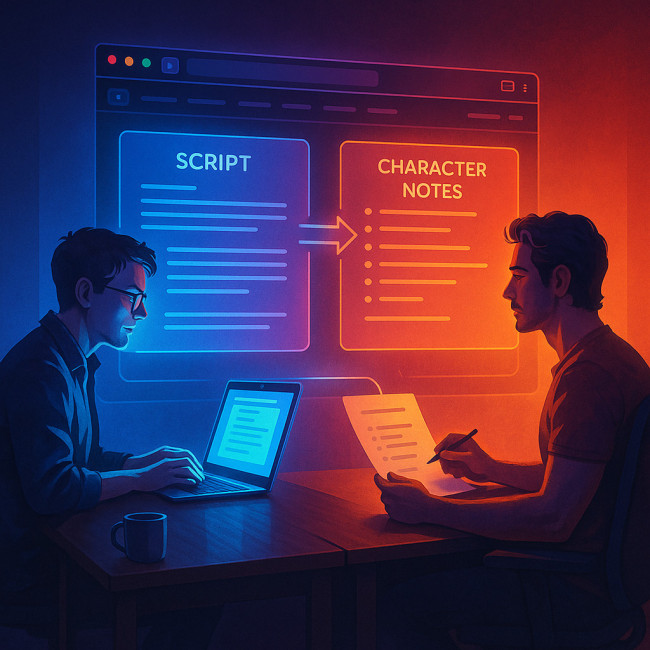Online hubs where screenwriters and actors connect to launch new stories
Tired of cold-calling agents or waiting for open casting calls? Modern collaboration platforms finally place screenwriters and actors in one digital room so stories move from draft to green-light faster. This guide compares the best hubs, key features, workflow tips, and common pitfalls—so you can secure talent, table-read efficiently, and pitch producers with confidence.
Why online hubs matter for screenwriter–actor collaborations

Scripts live and die by timing. When writers and performers meet early, characters breathe sooner, dialogue sharpens, and producers see marketable chemistry. Online hubs remove geography, manage files securely, and show real-time availability. The result: fewer stalled drafts and more polished projects ready for funding.
- Speed: Messaging threads and instant file swaps beat week-long email chains.
- Discovery: Advanced filters spotlight niche skills—think multilingual improv or action-ready stunt training.
- Credibility: Verified credits and peer reviews add assurance before you invest rehearsal hours.
Key features to look for in a collaboration platform
1. Intelligent matching algorithms
Platforms that analyse genre tags, role types, and availability slash your search time. Some even recommend collaborators you overlooked. Combine these with your own networking—digital networking tactics still boost match accuracy.
2. Secure script sharing and version control
A watermarked, time-stamped PDF vault is essential when circulating early drafts. Look for end-to-end encryption and clear permission layers. This keeps IP safe and prevents “creative drift” caused by actors working from outdated pages.
3. Integrated direct messaging
Quick brainstorms prevent overthinking. Yet etiquette matters: keep first contacts short, personalised, and benefit-focused. Review our messaging etiquette checklist to avoid sounding like spam.
4. Live table-read tools
Screen-sharing, multi-track recording, and low-latency voice channels allow instant playback and performance notes. They're a huge step up from basic video calls, particularly when collaborating across time zones.
5. Showcase pages with verified credits
Nothing accelerates trust like badges that pull from unions or guild databases. Actors should sync SAG-AFTRA IDs; writers can link WGA registrations. Learn how verified credit badges speed up shortlists.
Five standout online hubs worth testing in 2024
| Platform | Best For | Unique Selling Point | Pricing Model |
|---|---|---|---|
| Stage 32 | Indie films & pilots | Weekly pitch sessions with execs | Freemium + paid labs |
| Coverfly Collaborations | Script development | Integrates Red List ranking to surface hot writers | Free |
| Backstage Community | Actors seeking roles & table-reads | Robust casting call board with video auditions | Subscription |
| Artfolio Talent Grid | Global actor–writer matches | Data-driven matching & secure clip hosting | Freemium |
| The Black List Labs | High-bar screenplay feedback | Industry-review scoring that boosts discoverability | Per-script fee |
For example, the Artfolio Talent Grid lets you post a logline, upload audition sides, and receive actor self-tapes within 48 hours—ideal for proof-of-concept trailers.
Workflow: from first chat to green-lit project
- Draft a concise pitch (one-paragraph synopsis + core roles).
- Post on chosen hub with clear expectation of pay, timeline, and creative rights.
- Review auditions or writing samples. Shortlist and schedule a live read.
- Run a virtual table-read using shared markup tools. See remote table-read best practices for smoother sessions.
- Lock the cast & co-writer team, then create a shared production calendar (shoot estimates, funding milestones).
- Prepare pitch deck featuring clips from the table-read to woo investors or grants.
Common pitfalls and how to avoid them
- Scope creep: Agree on page counts and revision rounds before drafting begins.
- Ghosting: Set response time expectations in writing; platforms with activity trackers help.
- Unclear credit splits: Define “created by” and “written by” credits in a memorandum of understanding.
- Scheduling conflicts: Sync calendars and time zones at day one; send automated reminders.
- Payment disputes: Use escrow or milestone-based contracts that release funds upon deliverables.
FAQ
- Do I need an agent to use these online hubs?
- No. Most platforms allow direct sign-up. An agent helps with negotiations, but you can secure initial collaborations solo.
- Which file format is safest for sharing scripts?
- PDF with dynamic watermarking and disabled printing is industry standard for early drafts.
- How do I ensure my idea isn't stolen?
- Register your script with the appropriate guild or copyright office, and use platforms that log access history.
- Can I run profit-share projects on these hubs?
- Yes, but disclose the revenue model upfront and draft a simple profit participation agreement.
Quick quiz: Are you collaboration-ready?
Next steps
You now know which features matter, how to vet collaborators, and how to steer a project from “hello” to production-ready. Ready to put theory into action? Sign up to one hub today, craft a concise pitch, and schedule a 20-minute table-read. Momentum starts with the first click.
Call to action: Bookmark this guide, share it with your creative circle, and revisit after your first collaboration to refine your process.











